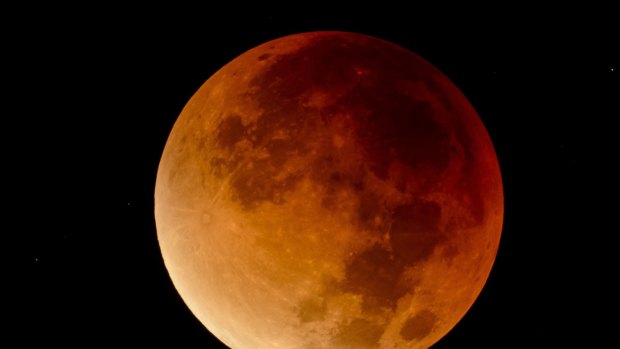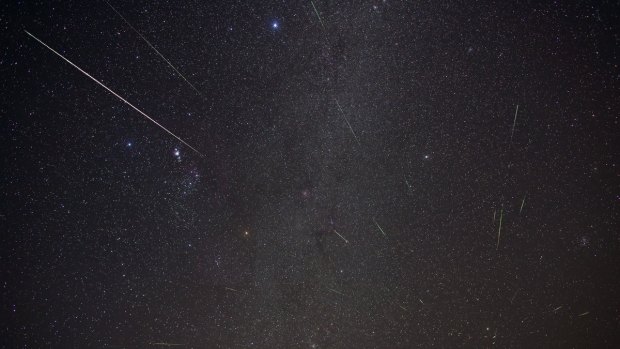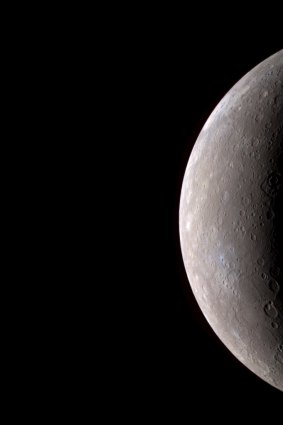This was published 7 years ago
Weekend sky abuzz with meteors, super new moon and Mercury transit
Weather permitting, stand by for one of the most spectacular meteor showers this year, as the planets align.
By Peter Spinks
If the predicted clouds part and the rain holds off, sky watchers are in for a rare celestial treat this weekend.
Throughout the small and late hours of Saturday and Sunday, meteors will streak across the sky while, at night-time, our natural satellite companion, the moon, will grow bigger but darker as it takes on super-new-moon status.
And, as if that weren't enough, on Monday there will be a transit of Mercury, during which the solar system's innermost orb will appear as a small black dot as it inches across the sun's golden face.
The Eta Aquarids, an annual meteor shower, are caused by the Earth passing through debris left over from the solar system's formation. As our planet ploughs through the material, tiny grains of debris will burn up in the form of meteors or shooting stars as they smash into the atmosphere at speeds of more than 200,000 kilometres an hour.

The perigee full moon, or supermoon appears red on a previous autumn sky.Credit: Peter Komka, AP
"During peak times in the early morning, around 6am, on Friday to Sunday, expect to witness a meteor every few minutes," said Australian National University astrophysicist Brad Tucker. The name, he explained, originates from the area they come from, the constellation Aquarius, and the star Eta Aquarius.
"The meteor shower will be one of the best of the year," said Swinburne University astrophysicist Alan Duffy. "With no moonlight to outshine these shooting stars, Australians in dark places may observe as many as 60 shooting stars an hour before dawn on Friday and Saturday morning."
Watch out for them in the eastern and north-eastern sky, he advised. "This will maximise your chance of observing the 'radiant' or region from which the meteor showers appear to originate."
"If there are bright lights in the way, it's best to just glance away into a darker region as the shooting-star trails will still be noticeable across the sky."

The previous meteor shower which, at its peak, produced 30 to 40 shooting stars an hour.Credit: Phil Hart
While this is going on, take time out to admire the super new moon. "This results from the moon orbiting the Earth in not a perfect circle but a slight oval known as an ellipse," Dr Tucker explained. "When the moon comes closer to us in its orbit, we call this the super new moon phase."
As the moon will be roughly 20,000 kilometres closer this weekend, it will seem much bigger than normal.

The innermost planet, Mercury. On Monday, it will come between us and the sun, appearing as a small black dot on the sun's face.
"As the moon lies closer to Earth, the tides it raises will be larger, with the effects noticeable on the beach in the form of unusually high and low tides, called spring or fall tides depending on which hemisphere you are in," Dr Duffy added.
Although it will not be observable from Australia, Monday's transit of Mercury will be like an eclipse. "This is because Mercury will be passing in front of the sun," Dr Duffy said.
During peak times in the early morning, around 6am, on Friday to Sunday, you can expect to witness a meteor every few minutes.
Dr Brad Tucker, ANU
Mercury's next transit will take place in 2019 and then again in 2032. "It happens more than a dozen times every century on average – and lasts for over seven hours as the tiny inner world appears as a shadowy disc slowly making its way across the sun's face," Dr Duffy said.
A previous transit, in 2014, was observed by NASA's Mars Curiosity rover from the red planet's surface, making Mercury the only transit to have been witnessed from an alien world.
"We use the transit technique to find new planets orbiting other stars," said Dr Tucker. "For scientists, the transit provides yet another great chance to find out what Mercury is like in terms of brightness and we can compare this to other planetary systems."
Despite the best efforts of astrologers to read meaning into such cosmic happenings, they are in fact unrelated, scientists say. "These events are not related – merely a cosmic coincidence," said Dr Tucker. "Most things in space take a very long time – millions of years. Sometimes, these long cycles of things all happen at the same time, like this weekend."
Dr Duffy agrees. "All three events are entirely unrelated and occur so close together just by chance," Dr Duffy said. "They are stark reminders that the world above us is a changing place. The impression that there's an unchanging sky of points of light is far from the case, as objects move around at truly breathtaking speed."
Please send bright ideas for new topics to pspinks@fairfaxmedia.com.au